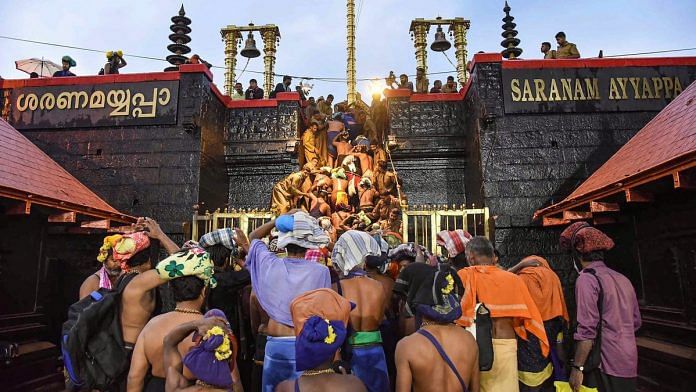New Delhi: The Supreme Court removed a decades-old bar in September last year when it allowed women of the menstruating age group (10-50 years) into Kerala’s Sabarimala temple. The main thrust of the judgment was that devotion could not entail gender discrimination.
Four months later, in January, a lawyer for the Kerala government told the Supreme Court that 51 women aged between 10 and 50 had entered the Sabarimala temple sanctum sanctorum. The reply followed widespread protests in Kerala over the entry of two women devotees, Kanakadurga and Bindu, who entered the sanctum before daybreak earlier that month.
By February, the court was saddled with 65 petitions challenging the verdict on the grounds of faith, as devotees believe Sabarimala’s presiding deity Ayyappa to be celibate. The petitioners include the National Ayyappa Devotees (Women) Association, the Nair Service Society, and the All Kerala Brahmins Association.
The hearing on the petitions lasted only for a day, on 6 February, after which the court reserved verdict in the case. The verdict is set to be issued today by a Constitution bench headed by Chief Justice of India Ranjan Gogoi, who retires later this week.
Also Read: Triumph of faith in Ayodhya verdict set to test SC in its Sabarimala review
‘Notions of untouchability’
CJI Gogoi had warned at the very outset that arguments should only be restricted to review of the judgment.
Advocate K. Parasaran, appearing for the Nair Service Society, sought a review on the ground that exclusion at Sabarimala temple was not driven by gender or sex, but religious faith and the character of the deity.
Sabarimala temple’s chief priest Rajeevaru Kandararu, the main review petitioner, argued: “Every devotee has a fundamental right to worship in a temple in a manner which is in sync with the character of the deity.”
Advocate Abhishek Singhvi, who appeared for Prayar Gopalakrishnan, the former chair of the Travancore Devaswom Board chair, which manages the temple and was a respondent, said the judgment failed to address the essential character of the deity, which constitutes a ground for review.
The board, however, took everyone by surprise and withdrew its objection to the entry of women inside the temple and urged people to “gracefully” abide by the Supreme Court’s verdict.
Senior advocate Jaideep Gupta, representing the Kerala government, opposed the review pleas and stated that Ayyappa devotees did not constitute a separate religious denomination and that restricting women from entering the temple was not a part of essential religious practice.
Senior lawyer Indira Jaising appeared on behalf of Bindu and Kanakadurga to argue a connected petition seeking security for the two, which was clubbed with the review pleas. She cited the alleged purification ceremony performed at the temple after the women’s entry to argue that the exclusion was rooted in notions of untouchability.
Also Read: Gogoi keeps up CJI tradition of retiring with a bang — has 4 big verdicts in last 2 weeks




May the judgment be imbued with the spirit of rationality and humanism Pandit Nehru – whose 130th birthday we celebrate today – sought to impart to his beloved countrymen in the early years of their freedom and nationhood, when levels of literacy were so much lower.